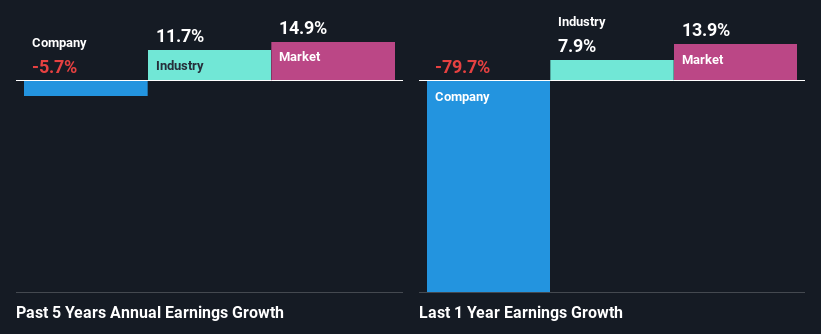Stock Analysis
- Italy
- /
- Consumer Durables
- /
- BIT:SAB
Are Sabaf S.p.A.'s (BIT:SAB) Mixed Financials Driving The Negative Sentiment?

Sabaf (BIT:SAB) has had a rough week with its share price down 10%. It is possible that the markets have ignored the company's differing financials and decided to lean-in to the negative sentiment. Long-term fundamentals are usually what drive market outcomes, so it's worth paying close attention. Specifically, we decided to study Sabaf's ROE in this article.
Return on Equity or ROE is a test of how effectively a company is growing its value and managing investors’ money. Put another way, it reveals the company's success at turning shareholder investments into profits.
See our latest analysis for Sabaf
How Do You Calculate Return On Equity?
Return on equity can be calculated by using the formula:
Return on Equity = Net Profit (from continuing operations) ÷ Shareholders' Equity
So, based on the above formula, the ROE for Sabaf is:
2.0% = €3.4m ÷ €170m (Based on the trailing twelve months to December 2023).
The 'return' is the yearly profit. That means that for every €1 worth of shareholders' equity, the company generated €0.02 in profit.
What Is The Relationship Between ROE And Earnings Growth?
Thus far, we have learned that ROE measures how efficiently a company is generating its profits. We now need to evaluate how much profit the company reinvests or "retains" for future growth which then gives us an idea about the growth potential of the company. Assuming everything else remains unchanged, the higher the ROE and profit retention, the higher the growth rate of a company compared to companies that don't necessarily bear these characteristics.
Sabaf's Earnings Growth And 2.0% ROE
As you can see, Sabaf's ROE looks pretty weak. Even when compared to the industry average of 13%, the ROE figure is pretty disappointing. Given the circumstances, the significant decline in net income by 5.7% seen by Sabaf over the last five years is not surprising. We believe that there also might be other aspects that are negatively influencing the company's earnings prospects. For example, the business has allocated capital poorly, or that the company has a very high payout ratio.
However, when we compared Sabaf's growth with the industry we found that while the company's earnings have been shrinking, the industry has seen an earnings growth of 12% in the same period. This is quite worrisome.

Earnings growth is an important metric to consider when valuing a stock. What investors need to determine next is if the expected earnings growth, or the lack of it, is already built into the share price. This then helps them determine if the stock is placed for a bright or bleak future. Is Sabaf fairly valued compared to other companies? These 3 valuation measures might help you decide.
Is Sabaf Using Its Retained Earnings Effectively?
In spite of a normal three-year median payout ratio of 33% (that is, a retention ratio of 67%), the fact that Sabaf's earnings have shrunk is quite puzzling. So there might be other factors at play here which could potentially be hampering growth. For example, the business has faced some headwinds.
Additionally, Sabaf has paid dividends over a period of at least ten years, which means that the company's management is determined to pay dividends even if it means little to no earnings growth. Our latest analyst data shows that the future payout ratio of the company over the next three years is expected to be approximately 31%. Still, forecasts suggest that Sabaf's future ROE will rise to 13% even though the the company's payout ratio is not expected to change by much.
Conclusion
On the whole, we feel that the performance shown by Sabaf can be open to many interpretations. While the company does have a high rate of reinvestment, the low ROE means that all that reinvestment is not reaping any benefit to its investors, and moreover, its having a negative impact on the earnings growth. With that said, we studied the latest analyst forecasts and found that while the company has shrunk its earnings in the past, analysts expect its earnings to grow in the future. To know more about the company's future earnings growth forecasts take a look at this free report on analyst forecasts for the company to find out more.
Valuation is complex, but we're helping make it simple.
Find out whether Sabaf is potentially over or undervalued by checking out our comprehensive analysis, which includes fair value estimates, risks and warnings, dividends, insider transactions and financial health.
View the Free AnalysisHave feedback on this article? Concerned about the content? Get in touch with us directly. Alternatively, email editorial-team (at) simplywallst.com.
This article by Simply Wall St is general in nature. We provide commentary based on historical data and analyst forecasts only using an unbiased methodology and our articles are not intended to be financial advice. It does not constitute a recommendation to buy or sell any stock, and does not take account of your objectives, or your financial situation. We aim to bring you long-term focused analysis driven by fundamental data. Note that our analysis may not factor in the latest price-sensitive company announcements or qualitative material. Simply Wall St has no position in any stocks mentioned.
About BIT:SAB
Sabaf
Sabaf S.p.A. designs, manufactures, and sells components for household cooking appliances.
Flawless balance sheet with reasonable growth potential.

